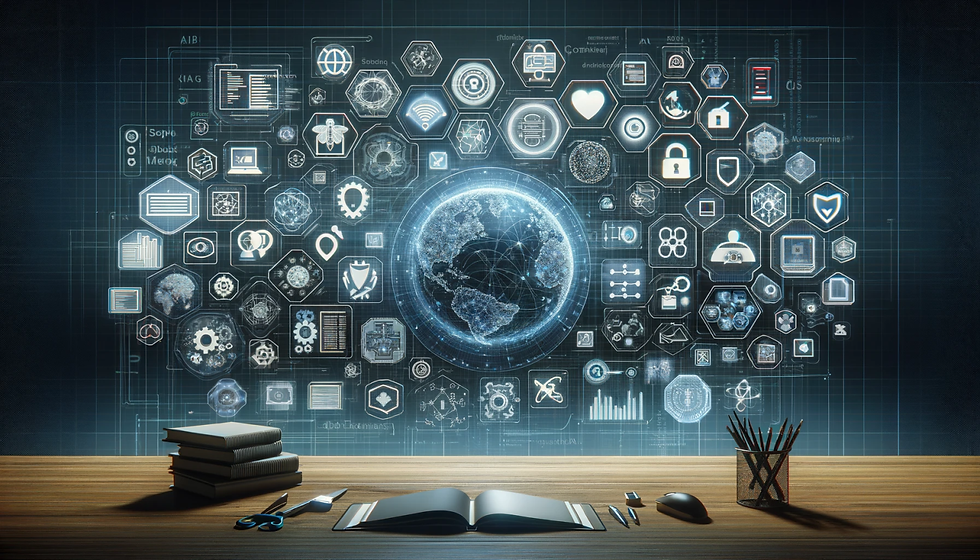Embracing a Symbiotic Tomorrow: Leveraging AI to Upskill
- Justin Press

- Feb 19, 2024
- 4 min read
Updated: May 22, 2024
In case you missed it, OpenAI’s Sora demo has taken the internet by storm. Sora is a text-to-video model, capable of generating hyper-realistic videos from text. This newest form of AI acts as a stark reminder of the exhilarating pace of AI advancement. However, amidst the whirlwind of technological change, one crucial aspect often gets overlooked: the potential for AI to enhance, not replace, the human experience.
Key Takeaways:
AI reshapes, not replaces, jobs: Automation will impact certain tasks, but new opportunities requiring human expertise alongside AI proficiency will emerge. (World Economic Forum estimates 97 million new jobs by 2025).
Symbiotic future: Humans and AI will work together, with AI handling repetitive tasks and humans focusing on complex, creative endeavors.
Upskilling is key: Continuous learning, familiarizing yourself with LLMs, and adapting to evolving roles are crucial for navigating the AI-powered future.
Instead of fearing a dystopian future dominated by machines, it's vital to envision a symbiotic relationship between humans and AI. Let's delve into how these innovative models can contribute to this collaborative future, where humans and machines work together to achieve remarkable things.
AI Reshaping, Not Replacing, Jobs
The reality is that AI is poised to reshape, not replace, jobs, ultimately leading to a future where humans and machines work in symbiosis to create a better world.
Instead of eliminating jobs, AI will increasingly automate repetitive, data-driven tasks, freeing up human time and energy for more complex, creative, and strategic endeavors. According to a recent Harvard Business Review piece, a 2023 Gartner survey highlights this shift, indicating that Generative AI will play a role in 70% of text- and data-heavy tasks by 2025, up from less than 10% in 2023. This doesn't signify job losses, but rather a transformation of job roles.
Imagine a doctor utilizing AI to analyze medical scans with unprecedented accuracy, allowing them to dedicate more time to personalized patient interaction and complex diagnoses. Similarly, a customer service representative empowered by AI chatbots can efficiently handle routine inquiries, while focusing on resolving intricate customer issues and building rapport.
This human-AI collaboration extends beyond specific professions. Business leaders, in partnership with HR, can redesign workflows to integrate AI tools seamlessly, upskill existing employees to leverage these new technologies, and identify internal candidates for the evolving roles. Additionally, hiring strategies can be re-evaluated, focusing on skills that complement AI capabilities, such as critical thinking, problem-solving, and emotional intelligence.
The focus shouldn't solely be on mitigating job displacement, but also on the numerous opportunities that AI presents. As automation takes over mundane tasks, it opens doors for innovation and exploration in various fields. New job roles will emerge, requiring a blend of human expertise and AI proficiency. This is evident in a recent World Economic Forum report which estimates that AI will create 97 million new jobs by 2025.
This transition requires a proactive approach. Embracing continuous learning and investing in reskilling initiatives is crucial to prepare the workforce for the AI-powered future.
Upskilling and Symbiosis
The recent advancements in large language models (LLMs) like OpenAI's ChatGPT, Anthropic's Claude, and Google's Gemini have sparked both excitement and apprehension. While concerns about job displacement exist, the reality is that LLMs are poised to become powerful collaborators, not replacements, in the workplace.
For employees seeking to upskill and thrive in this evolving landscape, embracing this symbiotic relationship with AI is crucial. Here's how you can get started:
Explore the Capabilities:
Experiment with different LLMs: Each model has unique strengths and weaknesses. Spend time exploring their functionalities through open-access platforms or readily available applications. This hands-on approach will help you understand their potential for various tasks.
Focus on practical applications: Identify specific tasks in your workflow that could benefit from LLM assistance. This could include tasks like research, data analysis, content creation, or even brainstorming new ideas.
Leverage their Strengths:
Boost your creativity: Leverage LLMs as brainstorming partners. Spark new ideas, explore different perspectives, and refine your creative output with their assistance.
Improve communication: Utilize LLMs for translation, content summarization, and writing assistance. This can enhance your communication skills and save you valuable time.
Remember the Limitations:
LLMs are still under development: They are prone to biases and factual errors. Always critically evaluate their output and use your own judgment before relying solely on their suggestions.
Human expertise remains irreplaceable: LLMs excel at handling data and generating text, but they lack certain critical thinking, problem-solving, and interpersonal skills that are essential for many workplace tasks.
Closing Thoughts
The rapid evolution of AI presents both challenges and opportunities. While some jobs may be transformed, the future of work is not about humans versus machines, but rather about humans and AI working together as partners. By upskilling yourself and embracing a symbiotic relationship with LLMs, you can unlock their potential to augment your work, enhance your creativity, and solve complex problems in ways never before imagined.
Remember, continuous learning and a growth mindset are key to navigating the AI-powered future. By actively engaging with these powerful tools and focusing on collaboration, you can ensure that AI becomes a force for good in your career, empowering you to thrive in the ever-evolving landscape of the future. So, take the initiative, explore the possibilities, and embrace the exciting journey of working alongside AI as your collaborator, not your competitor.





